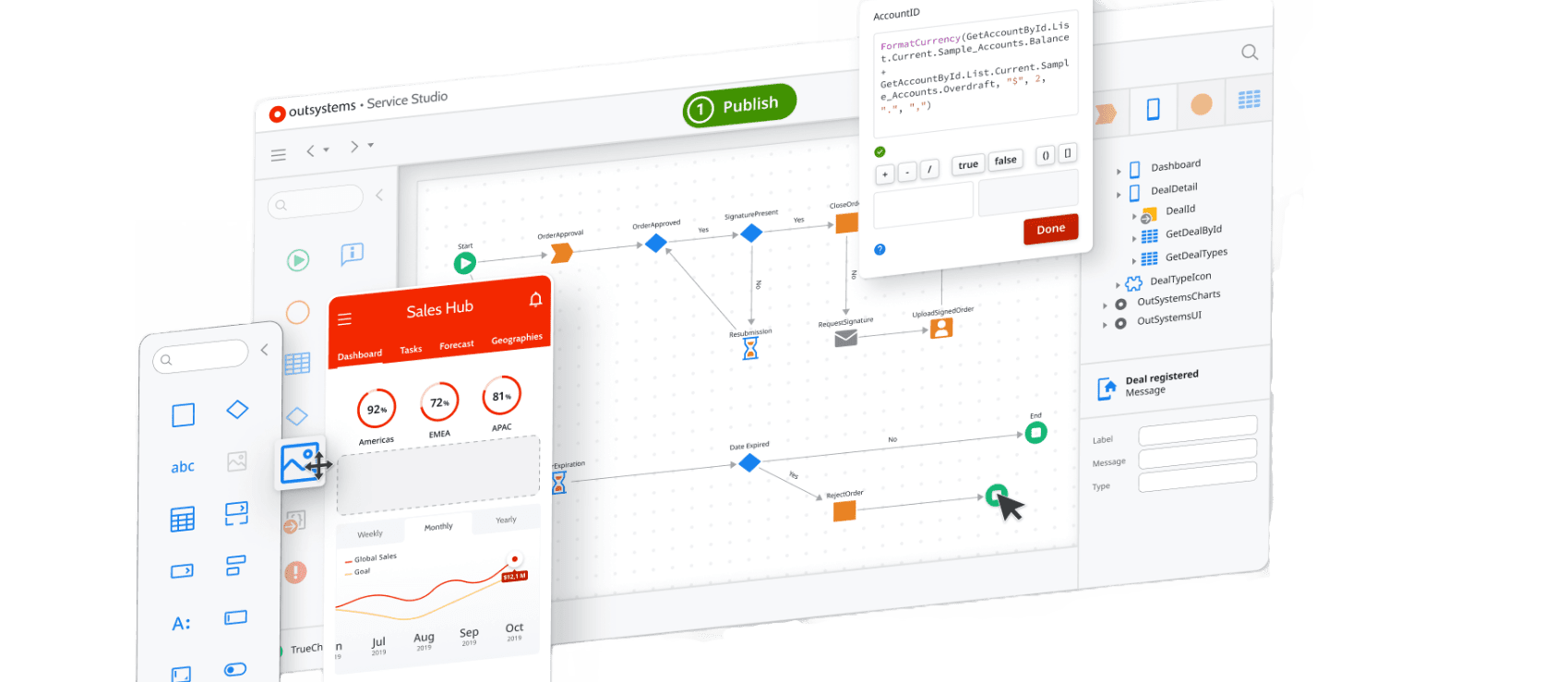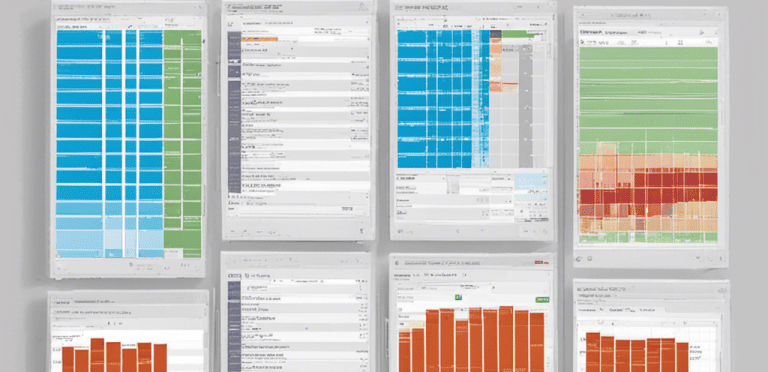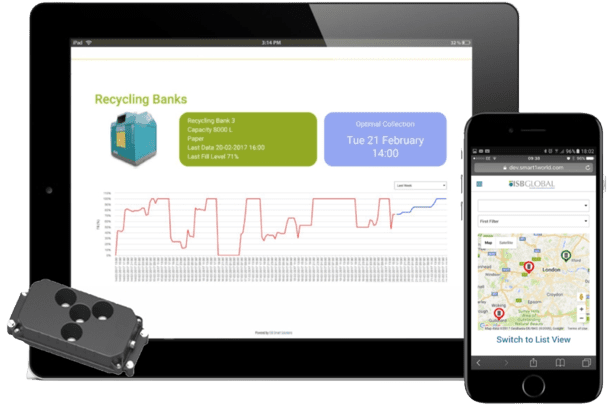How OutSystems handles technical debt Pritesh Pattni How OutSystems handles technical debt Technical debt has a significant impact on a business. It’s not just about the IT department – technical debt concerns every department in the business. That’s because it affects operations across the business, often resulting in inefficiencies, reduced productivity, squeezed margins, higher long-term costs, and poor commercial performance. So, it’s in everyone’s interest to identify the levels of technical debt in your business and to remedy those issues as quickly and reliably as possible – without leaving the business open to further technical debt in the future. There are several ways that technical debt can appear. In most cases, issues occur because of rushed or poor technology decisions in the past. Sometimes, these are down to budgetary concerns, where cheaper options, or those with limited capacity are chosen ahead of better technology. Technical debt can also be the result of: Poor coding – this is especially true where in-house development teams are coding without the required standardisations or processes, or where they are under pressure to produce applications as fast as possible, rather than being able to concentrate on accuracy and proper architecture. Inadequate documentation – technical teams change, and people come and go. But the technology remains in place, without a documented knowledge base, new team members are unable to understand the system properly, update it accurately or build on it properly. Legacy infrastructure – this is one of the most common forms of technical debt. Servers may be outdated, running slowly or unable to cope with more recent technologies. This can result in downtime, expensive maintenance and some applications being unable to work to their full potential. Lack of external support – where older systems are being used in your business, you may not be receiving the quality of external support you need. Third parties may be unable to support their product anymore, or products may no longer be compatible with each other, leading to gaps in knowledge and information. At the same time, the business may still be paying for expensive contracts or subscriptions that are no longer delivering proper value. These are just some of the more common areas of technical debt – you may find that your business has other issues. The real question is – what can you do about it? Technology: cost vs time vs quality? We’ve seen that most technical debt arises because one of the above issues – cost, time or quality – usually wins out over the others. Low cost or time-efficient solutions often result in technical debt, but businesses are wary of higher quality solutions because they incur additional costs and take more time to evaluate and implement. To help businesses reduce technical debt, we need a solution that balances cost, time and quality. For us, that solution is low code. Low code development platforms are increasingly becoming the go-to option for businesses who want to create agile, high-quality applications that meet both cost and time criteria. We believe that using low code gives businesses access to reliable coding that allows them to go to market faster, delivering business objectives without the risk of technical debt that hand coding often incurs. It’s important to note that, while low code reduces the need for much of the traditional coding we’re used to, it does still require significant development skills to ensure that the architecture, processes and documentation are high quality, and that the finished application has the design, functionality and up-to-date approach that today’s businesses expect. For that reason, we partner with OutSystems – one of the world’s leading low code platforms, both to create brand new applications, and to help businesses attack their technical debt with a proven, cost-effective solution. How can OutSystems handle technical debt? The OutSystems low code platform has been operating successfully for more than 20 years, giving developers and tech teams the ability to plan, design and create applications based on standard architectures and frameworks. This means there is no need for any hand-coded elements or engines, eliminating many of the issues that commonly cause technical debt. For example, when new code is written or existing code updated, OutSystems runs a feedback engine which immediately picks up any potential problems, alerting developers straight away, and providing guidance on the best fix or solution. This, alongside inbuilt application analysis, ensures that not only is the code accurate, concise and clean, but the operation of the whole application is as efficient as possible. Where businesses have identified technical debt that is having an impact on the wider business – for example, significant processes being managed by Excel spreadsheets with no integration to other essential systems, OutSystems low code offers a win-win solution. Why? Because it allows departments from across the business to have an input into solutions, and developers – either inside the business or from a third party – to manage complex applications easily and collaboratively. All this within stringent standards of architecture and application security. At each stage of the development process, OutSystems is working continuously to ensure that the application is secure, efficient and properly tested so that businesses can reduce their technical debt and achieve a more streamlined solution without the dreaded expense or time investment of a traditional hand-coding approach. Contact us to find out more. Recommended Posts The best of both worlds: How SAP and OutSystems combine for advanced outcomes The best of both worlds: How SAP and OutSystems combine for advanced outcomes Pritesh Pattni The best of both worlds: How SAP and OutSystems combine for advanced outcomes There’s no doubt that… Read More The synergy of design, code, and development The synergy of design, code, and development Pritesh Pattni The synergy of design, code, and development Like all disciplines, digital development works best when all the various elements are used… Read More What is the true cost of technical debt? What is the true cost of technical debt? Pritesh Pattni What’s the true cost of technical debt?
The synergy of design, code, and development
The synergy of design, code, and development Pritesh Pattni The synergy of design, code, and development Like all disciplines, digital development works best when all the various elements are used collaboratively, and where new approaches are created based on the input of experts in each area. Depending on the type of development, new technologies can be expensive and time-consuming to create, and this is only exacerbated when some parties are consulted late in the day, or assumptions are made. That’s why uniting design, code and development is seen as the best approach for a successful technology project. In this article, we look at why this synergy is important. What is design? For technology projects, design is the process of creating visual and functional concepts that are focused on delivering a great user experience. This often covers a range of design expertise, including graphic design, user interface design and user experience design. Working together, these designers use their experience and understanding of aesthetics, usability and psychology to build a visual approach that attracts users while accurately representing the end brand. What is code? Code, in the context of software development, refers to the instructions written in a programming language to define the behaviour and functionality of a system or application. It covers both frontend code, which is focused on the user interface and interaction, and backend code, which manages data storage, processing, and communication with servers and other systems. Code is used to translate design concepts into executable software, employing algorithms, data structures, and software architectures to bring ideas to life. There are usually two approaches to coding: traditional hand coding and low code. Hand-coding is where every element of the code is written by a professional developer and is often used on complex projects. Low code is an approach that uses a drag-and-drop interface to create certain elements of a project, reducing time and cost, and ensuring reliability. The type of coding used on a technology project will be determined by the type of project, timescales and budget. What is development? Development is the term given to the broader process of creating, deploying, and maintaining software solutions. It is often used just to describe the technical aspects of coding, but it also involves the strategic planning and management required to deliver successful products. Ideally, development teams will collaborate across disciplines, including design, engineering, quality assurance, and project management, to build software solutions that meet user needs and business objectives. Why collaboration matters To run a successful technology project, all these elements must come together. Design, with its focus on aesthetics, usability, and user experience, lays the foundation for intuitive interfaces and engaging interactions. Whether it’s crafting visually compelling layouts or mapping out user journeys, design serves as the initial touchpoint, drawing users into the product. Design – both for aesthetics and for usability – is a critical part of the process, giving coders the direction they need to create a workable solution. But ‘design’ and ‘code’ shouldn’t work in a vacuum. Of course, coders could wait until the design process is complete, and then take over, but the project will be far more efficient when designers and coders work together from the very beginning. This is where creativity and technical understanding can work together to create not just a functional and high-performing solution, but to manage the project in the best way from end to end. Designers provide developers with the blueprint for innovation, while developers empower designers with the tools to realize their vision. This synergy fosters a culture of creativity and refinement, where ideas evolve organically through continuous feedback and open conversations. Beyond individual projects Of course, collaboration helps individual projects to succeed. Sometimes, all the elements of design, code and development are based within internal teams, which makes this teamwork easier. On other projects, the project development team may be internal, while the design and coding is outsourced. In cases like this, it’s essential to bring teams together regularly to establish and build good relationships to help the project run smoothly. Beyond individual projects, this focus on collaboration is being encouraged across the technology industry. Leaders understand both the commercial benefits of working more collaboratively, and the fact that this approach delivers better outcomes for users. Agile methodologies, using iterative development and cross-functional teams, has blurred the lines between design and code, removing the risk of siloed thinking, and producing more efficient and effective results. Why low code is a good collaborative option In the context of uniting design, code, and development, low-code platforms offer several advantages over hand-coding approaches. First, they enable rapid prototyping and iterative development cycles. This helps to bring technologies to market faster, and results in more reliable end applications. Low code also streamlines the development process by eliminating complex technical details. This means the development team can focus on high-level functionality and business logic, rather than getting tied up with every small detail. By reducing the amount of hand coding required, using low code can increase productivity and efficiency, and drives faster, more cost-effective delivery. At ISB Global, we are a proud OutSystems partner. OutSystems is regularly named as a platform of choice for collaborative teams. It’s an open platform that accelerates development without compromising quality, and leaves room for easier adaptation and scalability. We use OutSystems low code both for our own market-leading application, Waste and Recycling One, and for the development projects we work on for clients. Contact us to find out more about how low code and collaborative working could help your business to build stronger technologies. Recommended Posts What is the true cost of technical debt? What is the true cost of technical debt? Pritesh Pattni What’s the true cost of technical debt? Technical debt comes in a variety of guises, and occurs for many different reasons. However your tech… Read More Is your software future-proofed? Is your software future-proofed? Pritesh Pattni Is your software future-proofed? As we move rapidly towards full digital transformation, businesses are relying
Is your software future-proofed?
Is your software future-proofed? Pritesh Pattni Is your software future-proofed? As we move rapidly towards full digital transformation, businesses are relying on a raft of software solutions to help them manage their day-to-day operations, store critical data securely, and drive the strategies that promote growth and long-term success. Not all software is equal, though. Older systems are often slower to use, less easy to interrogate, don’t integrate with other systems and can even be at a stage where the software company no longer offers updates or support. Today’s software must be designed and developed with an eye to the future. Whether you are building a system in-house, or buying systems in from elsewhere, the scalability, flexibility and adaptability of the software system must be key considerations. In this article, we talk about why this is so important, and how taking a low code approach could deliver the future proofing you need. Software is changing In fact, this isn’t a recent occurrence. Like all fundamental technologies, software development is changing all the time. Developers live in a fast-paced and competitive environment, where users have certain expectations and demands, and businesses want more software for their money. This can pose problems for the hand-coding approach – the traditional method of software development where developers hand-write their code from scratch. That’s because this is a more time-consuming way to write software – and therefore more expensive. It can also be more prone to errors or bugs, simply because it relies entirely on human authoring and testing. This is why, over the past 20 years, we have seen the emergence of a low code approach. Low code development uses a visual drag-and-drop interface, using pre-designed elements to improve both the speed of development and its accuracy. The ability to use a dedicated platform also promotes better collaboration between developers and their clients – whether they are internal or external – and also allows software to be built that can be updated or scaled quickly and easily. How low code supports future proofing So, low code reduces development time, removes much of the error risk, and helps developers to build flexible software. This in itself supports future-proofing, and there are a number of benefits to this approach: Agile development – using low code platforms supports a more flexible development lifecycle, which allows developers and organisations to respond quickly and accurately to changes in business requirements, market demands or competitive features. The ability to be able to quickly design, test and deploy software applications to help businesses flex to maintain or improve market position. Scalable approach – rather than going through a cycle of constantly upgrading or changing software to meet the demands of a growing business, a low-code approach allows developers to expand the current application to meet new needs. This may be extending functionality to a new department, bringing on board a business that has been acquired, or simply upgrading the software to allow for a more efficient approach. Less technical debt – ‘technical debt’ is a term used to describe software that can no longer deliver what the organisation needs. This slows down productivity and can actively get in the way of growth. With a low code development solution, the code is simpler, the ability to change or adapt is greater and so technical debt declines. Better security – this is a core requirement for all today’s software. Organisations are at constant risk of attack and need to demonstrate that they have put the security of their systems and their data first. While some businesses just focus on security, others also have to demonstrate compliance with both government and regulatory requirements. So today’s development is not just about building a future-proofed user experience; it’s about ensuring the organisation is always meeting or exceeding its security and compliance requirements. Why we use OutSystems OutSystems is a pioneer of the low code approach, and has been developing its platform for the past 20 years. It’s built up a loyal following among professional developers, who can see the numerous benefits of using its intelligence to build software faster, while also retaining control over design and architecture. We are a proud OutSystems partner, using its low code technology to build our industry-leading platform, Waste and Recycling One. We also use OutSystems to build discrete applications for clients, giving them the high quality, future-proofed development they are looking for at a price they can afford. Recommended Posts An evolutionary approach to software engineering An evolutionary approach to software engineering Pritesh Pattni Evolution. The gradual development of something to make it even better. It’s this approach that underpins the low code software… Read More How to choose a low code platform partner How to choose a low code platform partner Pritesh Pattni If you have a technology project or digital transformation programme, you are probably considering a low code solution. Low code offers a range… Read More What is low code technology? And why should you consider it? What is low code technology? And why should you consider it? Pritesh Pattni The demand for new and upgraded technology isn’t going anywhere. The human race continues to adopt new technologies to… Read More Where next? I’m an OutSystems Customer looking for Applications to accelerate my journey → I’m an OutSystems customer looking for patterns & features to accelerate my journey → I’m an OutSystems Customer using SAP and looking for an advanced integration engine → I’m an OutSystems customer and I need additional development support for my team →
The OutSystems low code platform guide – an introduction
The OutSystems low code platform guide – an introduction Pritesh Pattni If you’re considering using a low code solution for your next software project, you’ll want to know all about the various platforms and what they offer. Here, we’ll give an overview of the platform, why we’ve chosen to work with it, and how we use it. ISB Global is a proud OutSystems low code platform partner, using it on our own proprietary waste and recycling software solution as well as helping other organisations develop the applications they need to manage their processes more efficiently. What is OutSystems? Founded in 2001, OutSystems is one of the leading low code platforms. Businesses around the world use OutSystems to develop, digitise and automate processes, with minimal coding required. Outsystems has more than 400,000 community members, around 350 partners, and customers in almost 90 countries. Why is OutSystems so successful? Founder and CEO, Paulo Rosado, says it’s because the company hasn’t changed its original vision – to enable every company to innovate through the power of software. With around 1500 employees, the company is constantly striving to offer developers and their customers the very best low code experience, allowing them to be innovative and creative without having to spend hundreds of hours hand coding. OutSystems describes its platform as ‘high performance low code’. It says: “This is the low code that enables you to develop serious applications with serious productivity fast – the kind that eliminates waste and overhead so professional developers can get on with the creative business of designing and deploying uniqueness.” Learn the benefits of Low Code vs. Traditional Development Why did we choose OutSystems? Low code platform choices are many and varied. Many of the biggest names in IT and software offer a low code solution – and they are among many more dedicated low code offerings. So, with all this market choice, why did we choose OutSystems? ISB Global’s founder and CEO, Chris Williams says: “OutSystems is an advanced application platform designed to accelerate the development of software applications. It does this while delivering unrivalled levels of flexibility and efficiency. For ISB Global, this means we are able to develop and manage software in a faster, more efficient and cost-effective way. And these benefits can be passed on to our customers in the form of better service at a lower price.” OutSystems is one of three partners that we use for our flagship software, Waste & Recycling One. Alongside global technology leaders SAP and Amazon Web Services, OutSystems gives us an easy-to-use, easy-to-maintain, flexible way to build software for complex use cases. Being an OutSystems Partner demonstrates that we have high levels of expertise and competence across the platform, and it also gives us access to the exclusive tools and resources that can help us to build successful projects with our clients. We also collaborate with other OutSystems low code platform partners, giving us access to a wide pool of creativity and innovation, contributing to our continual learning and development and allowing us to share our own expertise across the community. To learn more about how OutSystems works and its benefits, take a look at the OutSystems low code platform website, where there’s a library of useful articles and information to get you started on your low code journey. If you’d like to find out more about how OutSystems low code could help deliver your project faster, with reduced costs and a quicker route to market, why not contact us for a chat today? Or sign up for a free demo of the OutSystems platform in action. Recommended Posts How to choose a low code platform partner How to choose a low code platform partner Pritesh Pattni If you have a technology project or digital transformation programme, you are probably considering a low code solution. Low code offers a range… Read More What is low code technology? And why should you consider it? What is low code technology? And why should you consider it? Pritesh Pattni The demand for new and upgraded technology isn’t going anywhere. The human race continues to adopt new technologies to… Read More What does it mean to work with an OutSystems Partner? What does it mean to work with an OutSystems Partner? Pritesh Pattni What does it mean to work with an OutSystems partner? When you’re planning a software project, you want to look for a development… Read More Where next? I’m an OutSystems Customer looking for Applications to accelerate my journey → I’m an OutSystems customer looking for patterns & features to accelerate my journey → I’m an OutSystems Customer using SAP and looking for an advanced integration engine → I’m an OutSystems customer and I need additional development support for my team →
Spreadsheet Mindset
Challenging the ‘Spreadsheet mindset’ Pritesh Pattni All businesses use spreadsheets – they are a staple of organisations everywhere. And, while they deliver a wide range of benefits, using spreadsheets for some business processes can be slow and prone to error. That’s why many businesses are considering moving some of the processes currently managed by spreadsheets, onto apps where the goal is typically to improve data accuracy, streamline processes, enhance collaboration. In principle, this sounds like a great idea, and while it will require some up-front investment, it will save money in the longer term. However, there are a few things to be mindful of to ensure the change from a spreadsheet to an app delivers benefits to the business. What is the spreadsheet mindset? This is a term we use to describe the way that some businesses approach replacing spreadsheets with an app. Simply put, it’s when people decide they just need the app to do what the spreadsheet currently does. By replicating the content, formulas and outcomes of the spreadsheet, the business feels it will have accomplished a digital transformation that improves productivity and efficiency. To our minds, there are some fundamental flaws in this approach – flaws that lead to businesses spending a lot of money on app development and just getting a very expensive new spreadsheet for their money. Let’s look at the key dangers of the spreadsheet mindset. You’re recreating something that might not be working – simply turning your spreadsheet into an app won’t transform the way you do things. If you’re struggling with the way your spreadsheet currently works, you need to spend some time considering what you want and how to get there before you spend any money on app development. You haven’t consulted your users – knowing the target audience is one of the most fundamental aspects of app development. Without understanding who’s using the app, you can’t possibly design something that works for them. If a developer agrees to transfer your spreadsheet process to an app without asking about your users, beware. You haven’t thought about the future – designing an app to manage today’s process is good; developing something that is scalable and adaptable for the future is even better. Why spend thousands of pounds for something that might be out of date in 12 months’ time? Many business app failures occur because there’s been no planning for what might come next. You’re jumping on a bandwagon – this is easy for businesses to do, particularly if the competition is adding apps and new technology to their business. But app development is expensive and you need to be able to show a return on your investment. So rather than changing a spreadsheet process to an app just for the sake of it, always make sure you’ve got a clear business case. Why move away from spreadsheets? There are certainly many arguments in favour of ditching spreadsheets. They can be cumbersome and sometimes unreliable. They are difficult to keep secure, and a single error can create chaos. For example, during the 2012 London Olympics, someone on the ticketing team keyed in 20,000 remaining tickets rather than 10,000. So the tickets oversold, and it cost the organisers more than £500,000 to manage the issue. Business leaders know that using spreadsheets can make them vulnerable. They are looking for process solutions that are more secure, more reliable, operate faster and contribute positively to productivity. They want technology that can be used simultaneously by staff members wherever they are, and whatever devices they are using. And apps are the ideal answer. Properly designed and developed, they are an excellent investment, protecting the business for the future, simplifying processes and bringing teams together. How to get it right The first step to successfully transitioning from a spreadsheet to an app is to sit down and plan exactly what you need the app to do. This includes setting out the reasons why the spreadsheet approach isn’t working for you, and considering what your ideal app would look like – both now and in the future. Once you have an outline idea of what you want, you need to find the right development team to work with you. The best option for this type of app is low code – this is where the app is built on a dedicated platform, using a combination of drag-and-drop elements and some traditional coding. Low code delivers a faster build, a reliable solution and the ability to integrate with other systems – without the much larger costs incurred by traditional hand coding. There are lots of low code app developers about, and it can be difficult to know who to work with – particularly if this is your first venture into the world of business apps. So, to avoid getting stuck in an expensive spreadsheet mindset, here are some tips on finding your low code development partner: Which platform do they use? There are a number of low code platforms, and you want to work with a developer who is experienced with a mainstream platform – preferably as a partner organisation. This shows that your development team will have in-depth understanding of the platform, so that they can build the best technology for you. Common platforms include OutSystems, Quickbase, Salesforce, Appian and Microsoft Power Apps. What questions do they ask? In order to build you an app that does everything you need, your development will need to know about your business, the app users, the key processes, future uses and any other processes the app will need to integrate with. The fewer questions your developers ask, the more wary you should be. What experience do they have? There are plenty of low code developers who only focus on taking excel processes and convert them to apps. This might seem like a bonus, but it means they don’t have the wider experience that often comes in useful for building a reliable, useful app. Talk to your developers about the types
BinLogix App
BinLogix Bin sensors with a pre-integrated IoT mobile and web app. GET IN TOUCH → Challenge Keeping materials from recycling banks segregated reduces the possibilities of contamination, saving 1000’s of tonnes being sent to landfill. All operators however face one major problem. How do they know when their containers are full? Overfilling will breach a service level agreement and early servicing wastes money, inflating your charges, carbon footprint, congestion and environmental impact. Guessing is a problem. Solution BinLogix bin sensors take the guesswork out of your waste management. Our sensors enable your bins to tell you when they need emptying, enabling you to schedule collections only when they’re needed. Each low-cost bin sensor makes use of our fill level forecasting technology to remotely report its location and fill level. The risk of overflow is a thing of the past and costs of servicing your recycling bank comes down. Benefits With the BinLogix bin sensors and app, you now get full visibility of the collection requirements across your network, so you can adjust and optimise collection routes and service scheduling to meet requirements in the most efficient way. Streamline your recycling bank waste collection immediately and build a detailed picture of bin usage, enabling you to identify areas overserved with bins and reallocate resources to areas more in need. Plan your project → Real-time visibility and monitoring. Increased efficiency & productivity. https://www.isb-smartsolutions.com/wp-content/uploads/2022/09/BinLogix-video.webm Join the smart community Subscribe You have been successfully Subscribed! Ops! Something went wrong, please try again.
ISB Global Smart Solution’s SAP Partnership
SAP Partnership ISB Global Smart Solutions is a proud SAP Partner. We are proud to partner with SAP, the global leader in Enterprise Resource Planning (ERP) Software. We help clients deploy SAP for the management of business processes, ensuring seamless and full integration with OutSystems. GET IN TOUCH → World leading ERP solutions. SAP delivers control and clear visibility of key governance and compliance management processes. Integrated reporting and analytics provide superior business intelligence, capturing critical information for real-time access and insight. By centralising data management, SAP provides multiple functions with a single view of the truth, in turn creating accelerated workflows, improved operational efficiency, raised productivity, enhanced experiences and increased profits. Learn more → SAP Enterprise Resource Planning (ERP) transforms business with integrated, intelligent functions. It delivers automated company-wide processes. It uses has industry best practices and employs real-time embedded analytics. SAP S/4 HANA Cloud ERP is a solution for large enterprises. It has built-in intelligent technologies including AI, machine learning, and advanced analytics. This technology is helping companies to adopt new business models & manage change at speed. SAP Business One ERP for small companies delivers a single affordable solution to gain greater insight. This allows companies to make informed decisions based on real-time information. Therefore, you can focus on driving profit and growth. SAP ByDesign ERP for mid-size companies delivers pre-built processes in finance, sales, product management, and purchasing on a single unified solution. This allows you to connect all functions across your business with best practices and analytics. Plan your project → Plan your project → Join the smart community Subscribe You have been successfully Subscribed! Ops! Something went wrong, please try again.
Unlock the Power of Your IT Systems – ebook
eBook: How to Unlock the Power of Your Existing IT Systems. Learn how a platform approach can enable you to create innovative solutions to increase productivity and efficiency while improving user experience. In this eBook, you will learn how to: → Modernize at your own pace→ Gain the speed and agility to innovate→ Extend, refactor, or re-build your systems Leading software, leading partner. As an SAP and OutSystems partner, ISB Global Smart Solutions is alone in it’s delivery potential. Let’s turn your big ideas into intuitive software and drive your digital transformation. BOOK YOUR CONSULTATION →









